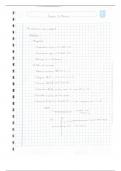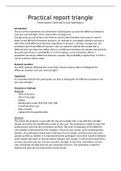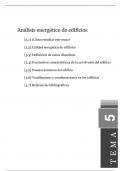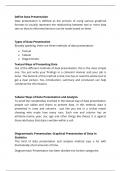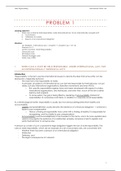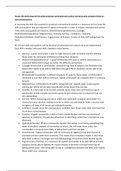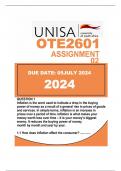Van de Ven, A. H. (2018). Academic-practitioner engaged scholarship. Information and
Organization,
28(1), 37-43.
Akkermans, H. (1993). Participative business modelling to support strategic decision
making in
operations—a case study. International Journal of Operations & Production Management.
Forrester, J. W. (1992). Policies, decisions, and information sources for modeling.
European Journal of
Operational Research, 59(1), 42-63
Lecture 2
Sterman, J. (2010). Business dynamics. Irwin/McGraw-Hill. Full book can be downloaded
online, Chapter 5 provides a detailed guideline on how to make conceptual system dynamics
models (Causal
Loop Diagrams).
Kim, D. H. (1992). Systems archetypes I (Vol. 1). Pegasus Communications.
Lecture 3
Akkermans, H. (2014). Supply Chain Dynamics: Mastering Disruptive Change in
Innovation-Driven
Industries. Educatieve Uitgeversgroep. Chapter 2 (which is added to Canvas) provides an
introduction
into developing quantitative system dynamics models.
Bezemer, J. J., & Akkermans, H. (2003, May). Not with a bang, but with a whimper:
Understanding
delays in semiconductor supply chain dynamics. In 21st International Conference of the
System Dynamics Society, July (pp. 20-24).
Lecture 4
Akkermans, H., & Vos, B. (2003). Amplification in service supply chains: An exploratory
case study from the telecom industry. Production and operations management, 12(2), 204-
223. (download link for erratum that contain the equations for workload)
Akkermans, H. (2014). Supply Chain Dynamics: Mastering Disruptive Change in
Innovation-Driven Industries. Educatieve Uitgeversgroep.
o Chapter 4: The curse of cyclicality: Managing semiconductor supply chain dynamics.
o Chapter 9: The service quality cascade: Managing ramp-ups in service supply chains.
Lecture 5
Sterman, J. (2010). Business dynamics. Irwin/McGraw-Hill. Full book can be downloaded
online, Chapter 21 provides a discussion on model validity and an overview of tests that are
useful to test the quality of a model.
Zolfagharian, M., Romme, A. G. L., & Walrave, B. (2018). Why, when, and how to
combine system dynamics with other methods: Towards an evidence-based framework.
Journal of Simulation, 12(2), 98-114.
Lecture 6
Akkermans, H. (2014). Supply Chain Dynamics: Mastering Disruptive Change in
Innovation-Driven Industries. Educatieve Uitgeversgroep.
,o Chapter 4: The curse of cyclicality: Managing semiconductor supply chain dynamics.
o Chapter 9: The service quality cascade: Managing ramp-ups in service supply chains.
Lecture 7
Akkermans, H. A., & Vennix, J. A. (1997). Clients' opinions on group model‐building: an
exploratory study. System Dynamics Review: The Journal of the System Dynamics
Society, 13(1), 3-31.
Meadows, D. H. (1999). Leverage points: Places to intervene in a system.
,Lecture 1
Article 1: Policies, decisions and information sources for modeling – Jay W Forrester
Abstract:
A simulation model is based on explicit statements of policies (rules) that govern decision
making in accordance with conditions that may arise within the system being modeled. The
decision-making process consist of 3 parts:
1. Formulation of a set of concepts indicating the conditions that are desired
2. The observation of what appear to be the actual conditions
3. Generating a corrective action to bring apparent conditions towards the desired state.
The model should generate 'true' conditions of underlying variables but, in general, these true
conditions are not available to people in real systems and should likewise not be used directly
for decision making in a model. Distorted and delayed information about true conditions
forms the basis for creating the values of desired and of apparent conditions. Corrective action
will in turn be delayed and distorted by the system before influencing actual and then apparent
conditions. In modeling business and economic behavior, and in representing policies and
decision making, all kinds of information should be used, not merely numerical data. Rich
stores of information about governing policies and economic structure are available from
mental data bases built up from experience and observation.
Good or bad manager? (Management & decision making)
Management is the process of converting information into action this process is called
decision making
Decision making is controlled by various explicit and implicit policies through which
available information is interpreted.
Policies are rules that states how day-by-day operating activities are made.
If management is the process of converting information into action, then management success
depends primarily on what information is chosen and how the conversion is executed. The
difference between a good manager and a poor manager lies at this point between information
and action. Hereby everyone has of course many sources to use information from. However, a
manager can only select from a fraction of sources of all available information. Even then a
manager (or we) makes incomplete and erratic use of selected information. A manager sets
the stage for action by choosing which information sources to take seriously and which to
ignore. A manager's success de- pends on both selecting the most relevant information and on
using that information effectively. How quickly or slowly is information converted into
action? What is the relative weight given to different information sources in light of the de-
sired objectives? How are these desired objectives created from available information?
1.System dynamic models
Within system dynamic models you can look at the managers as information converters to
whom information flows to and from whom decision streams flow of that control actions
within organizations. The key is as a manager to convert the information into decision at
control points in an organization where it can be effectively used.
A manager receives incoming information flows and combines these into streams of
managerial instructions.
, When viewing a manager as information converter via the system dynamic approach it is
evident. That you look at information flows and and decision makings. In an organization
there is a complex interlocking network of information channels. Information channels
emerge at various points to control physical processes such as hiring of employees, building
of factories, and production of goods. Every action point in a system is controlled by a local
decision point that depends on information sources in other parts of the organization and the
surrounding environment.
For instance the example of the decision stream in the simplest framework:
Figure 1 shows a decision stream in the simplest framework of an information-feedback
system. Information is the input to a decision-making point that controls action yielding new
information. The diagram shows the fundamental structural relationship.
In each box there are delays. Information about actions is not immediately available.
Decisions do not respond instantaneously to available information. Time is required for
executing actions indicated by decision streams. Likewise, each box contains amplification
which I use here in all of its positive, negative, and nonlinear senses.
In the model information is the input to a decision-making point that controls the actions
which again yields new information. The ins and output can be negative or positive (negative
or positive feedbackloops). Note: in each box there are also delays, since information is not
immediately available, and decisions do not immediately respond to information.
Industry information loops (more realistics)
an industrial system is however not so simple as the information loop
above. Instead, it is very complex multi-loop with a lot of decision
making, information streams and actions that again add new information.
Also, loops can be interconnected to each other and therefore influencing
other information loops.
In reality (what happens most of the time)
Likewise, feedback loops are the organizing structure around which system dynamics models
are constructed. Although 'feedback' has become a word in the public vocabulary. Most
discussion, whether in cocktail parties or corporate board meetings, is organized as in Figure
3. A problem is perceived, an action is proposed, a result is expected. But the result often does
not occur. The reason lies in the more realistic structure of Figure 4, as extended to more
complexity in Figure 5.
(This is crossed in slides as this is the wrong
way of thinking!)


